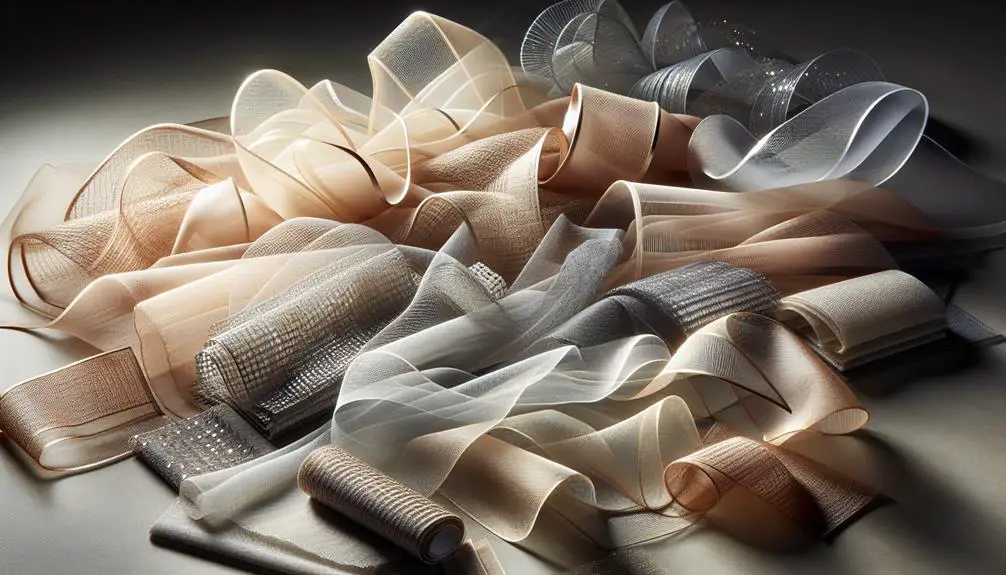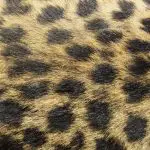Organza comes in quite a few types, each with its own texture and charm. I've come across five main varieties. There's silk organza, known for its strength and lightness. Polyester organza is super durable and good for crafts since it's easy to work with. Crystal organza shines with its transparency and lightweight feel. Mirror organza adds a glossy, reflective touch to outfits. For something extra special, embroidered organza features beautiful stitch work like florals or sequins. And don't forget the fun printed styles like polka dots and animal prints! Each type has a unique vibe, perfect for different projects. Stick around to uncover more on how these fabrics can be used!
Table of Contents
Key Takeaways
- There are several specific types of organza including silk, polyester, crystal, mirror, and embroidered.
- Each type of organza has unique properties and uses, ranging from sheer and light to embellished and reflective.
- Silk and polyester organza are common, with silk being natural and polyester synthetic, both known for durability and texture.
- Crystal and mirror organza are notable for their visual effects, such as transparency and reflective surfaces.
- Embroidered and printed organza introduce artistic elements like floral, geometric, and sequin designs.
Silk Organza Characteristics
Silk organza is light and sheer, yet it's surprisingly strong and durable. When I first handled it, I was amazed at its resilience despite its delicate appearance. This fabric is woven from silk fibers, which gives it a luxurious feel and a slight sheen that's quite eye-catching.
One of the key features of silk organza is its stiffness. Unlike other sheer fabrics that may drape softly, silk organza has a crisp texture. This makes it perfect for creating structured designs in fashion. It holds shapes well, so I find it ideal for full skirts and sleeves that need to maintain form.
Another important aspect is its ability to be dyed in a wide range of colors. This versatility is a huge advantage when I'm experimenting with different palettes in my designs. Plus, its smooth surface reflects light beautifully, adding depth and dimension to the colors.
Managing silk organza requires some care, though. It's prone to wrinkling and needs gentle handling. I always recommend dry cleaning to maintain its quality and texture. Using it well can truly elevate any piece, making mastery of this fabric rewarding for any designer.
Polyester Organza Varieties
Now, let's talk about polyester organza.
I'll explore how durable it is, how we can use it for crafts, and the best ways to take care of it.
Each point offers something unique, so let's get into it!
Polyester Organza Durability
Polyester organza varieties offer impressive durability, making them a practical choice for many applications. They're tough, really! Unlike silk organza, these synthetic versions stand up to a lot more wear and tear. They resist shrinking and fraying, which is a huge plus for anyone who's had to deal with delicate fabrics that fall apart too easily.
What's more, polyester organza holds its shape well. You won't see it going limp on you. It's also resistant to stains and wrinkles, which saves a lot of hassle in maintenance. So, if you're looking for a fabric that can take some rough handling and still look fab, polyester organza should be at the top of your list.
Crafting With Polyester Organza
When crafting, I find that polyester organza is incredibly versatile and easy to work with. It's great for a variety of projects. Whether I'm making fancy dress costumes or adding a touch of elegance to home décor, this fabric fits the bill. It holds shapes well, which is perfect for creating puffy sleeves or structured bows. Plus, it comes in many colors and patterns, giving me lots of creative freedom.
Polyester organza is also pretty forgiving. If I mess up a cut, I can usually find a way to hide it or work around it. It's a good choice for both beginners and seasoned crafters. I definitely recommend giving it a try in your next project!
Caring for Polyester Organza
To keep your polyester organza looking its best, it's crucial to follow proper care guidelines. This fabric can be a bit tricky, but I've got some tips that'll make it a breeze. Here's how I keep mine in tip-top shape:
- Wash Gently: Always use cold water and a mild detergent. Handwashing is best to avoid snags and tears.
- Avoid Heat: When drying, don't wring it out. Just lay it flat or hang it to dry. Stay away from the dryer!
- Iron Carefully: Use a low heat setting and a pressing cloth to avoid melting or scorching the fabric.
With these simple steps, your polyester organza will stay fabulous for all your future projects!
Crystal Organza Features
Let's talk about crystal organza now.
It's cool because it's really see-through, super strong, and easy to take care of.
I'll also show you some popular ways people use it.
Crystal Organza Transparency
Crystal organza stands out for its remarkable transparency, giving it a sheer, ethereal quality. This type of fabric is perfect for those looking to add a touch of elegance and lightness to their creations. Its transparency isn't just about looks; it's also functional in various design contexts.
Here's what makes crystal organza a favorite choice:
- Light Diffusion: It's great for softening light, adding a dreamy glow to any setting.
- Layering Potential: You can layer it without the outfit or decor piece looking bulky.
- Visual Depth: Despite its sheerness, it adds complexity to the visual presentation of garments and decorations.
I've found it to be incredibly versatile in my projects, especially for creating flowing dresses and decorative overlays.
Durability and Care Tips
Despite its delicate appearance, crystal organza is surprisingly durable and easy to maintain. You'd think it'd be a hassle with its sheen and texture, but it's tougher than it looks. When it comes to washing, stick to gentle cycles or hand wash to keep it in top shape. Avoid harsh chemicals; a mild detergent will do the trick perfectly.
Ironing? Yes, but keep it at a low heat setting. Too much heat can ruin the fabric's unique properties. And here's a pro tip: use a pressing cloth between the iron and the organza. This protects the fabric's finish and prevents unwanted shine spots. With these simple care steps, your crystal organza will last beautifully.
Popular Usage Examples
Where do you commonly see crystal organza used? This shimmering fabric is everywhere once you start looking! Here are a few places you'll definitely spot it:
- Weddings: From flowing bridal gowns to decorative table overlays, crystal organza adds a touch of elegance and sparkle.
- Fashion: Designers love using it for evening dresses. Its light-reflective properties make any outfit stand out.
- Home Decor: It's great for sheer curtains that catch the light beautifully or as a fancy addition to cushion covers.
Mirror Organza Explained
Mirror organza stands out with its reflective surface that adds a unique dimension to fabric design. It's a type of organza known for its shiny finish that almost mimics a mirror—hence the name. Made typically from polyester, it draws attention due to its lustrous sheen and smooth texture.
I love how this fabric plays with light. It catches and reflects light in a way that can really make a garment pop. It's not just visually appealing; it's also quite sturdy for a sheer fabric. This combo of beauty and strength makes it a favorite for designers who want to add a touch of glamour without compromising on durability.
You'll often see mirror organza used in evening wear, like gowns and dresses, where it adds a layer of sophistication. It's also popular in accessories and home decor, particularly in settings where you want to catch the eye with light play.
Working with mirror organza can be a bit tricky due to its slippery nature. It requires a gentle hand and patience, especially during cutting and sewing. But mastering its use can really elevate your projects, giving them a professional and polished look.
Embroidered Organza Types
Embroidered organza adds a touch of elegance with its intricate patterns stitched into the sheer fabric. I'm particularly drawn to how these designs transform a simple piece of organza into a work of art. Let's dive into the different types you might come across.
- Floral Embroidered Organza: This type is quite popular. Think delicate flowers stitched across the surface, ranging from subtle to bold. It's perfect for spring and summer outfits or even home décor like curtains.
- Geometric Embroidered Organza: For a more modern look, geometric patterns are your go-to. These include straight lines, circles, or any abstract shapes that give a contemporary edge to traditional organza.
- Sequin Embroidered Organza: If you're all about the sparkle, this type is fascinating. Tiny sequins are sewn onto the fabric, usually accompanying some form of embroidery. It catches the light beautifully, ideal for evening wear.
Each type of embroidered organza serves its unique purpose, enhancing garments and decorations alike. Whether it's the soft allure of floral patterns or the bold statement of geometric designs, there's an embroidered organza that suits every taste and occasion.
Printed Organza Styles
Printed organza, with its vibrant patterns, really brings a playful and colorful twist to the classic sheer fabric. Each design not only adds visual depth but also tells its own unique story. Let's dive into some popular styles and how they make us feel.
| Style | Emotion Evoked |
|---|---|
| Floral Print | Joyful and Fresh |
| Geometric Shapes | Bold and Structured |
| Animal Print | Wild and Free |
| Abstract | Creative and Mysterious |
| Polka Dots | Fun and Youthful |
Floral prints bring a touch of nature to your wardrobe, making you feel like you're walking through a vibrant garden. Geometric shapes offer a sense of order and boldness, perfect for making a strong impression. Animal prints unleash a wild, untamed spirit, great for when you're feeling adventurous.
Abstract prints are for those days you're feeling particularly creative, ready to stand out in a crowd. Polka dots? They're just plain fun, evoking a youthful exuberance that's hard to ignore.
Frequently Asked Questions
How Is Organza Fabric Typically Used in Fashion Design?
In fashion design, I often see organza giving fairy-tale gowns their airy lift. It's perfect for overlays, skirts, and sleeves, adding that dreamy, ethereal quality we all love in high-fashion pieces.
Can Organza Be Washed or Is It Dry-Clean Only?
I've found that organza can generally be hand washed carefully, but it's often recommended to dry-clean it to maintain its texture and sheen, especially for silk organza which is more delicate.
What Is the Environmental Impact of Producing Organza?
I've been digging into the environmental impact of producing organza. It's pretty heavy, involving significant water, chemicals, and energy. It's crucial we consider these factors when choosing fabrics for sustainability's sake.
Are There Any Cultural Significance Associated With Organza Fabrics?
Yes, organza fabrics hold significant cultural value, especially in fashion and ceremonial attire across various cultures. They're often used in wedding dresses and traditional garments, symbolizing purity and celebration.
What Are Common Mistakes to Avoid When Sewing With Organza?
Navigating the delicate dance of sewing organza, I've learned not to rush. Avoiding sharp needles that snag and high heat that melts is key. Gentle handling and patience always yield the best results.
- The Use of Nonwovens in Construction and Civil Engineering - July 11, 2025
- The Use of Nonwovens in Construction and Civil Engineering - July 11, 2025
- The Use of Nonwovens in Construction and Civil Engineering - July 11, 2025




